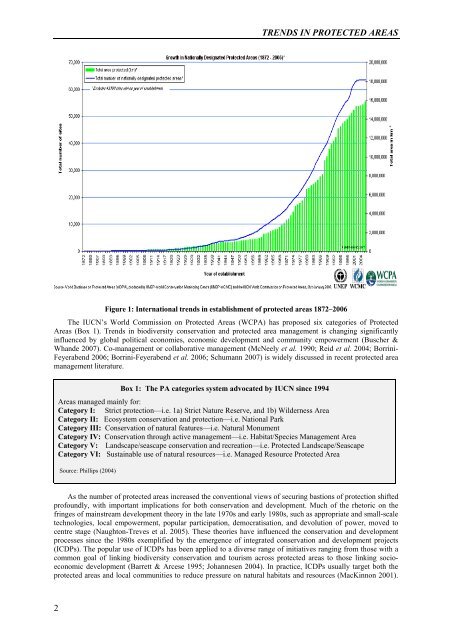TRENDS IN PROTECTED AREAS - Sustainable Tourism CRC
TRENDS IN PROTECTED AREAS - Sustainable Tourism CRC
TRENDS IN PROTECTED AREAS - Sustainable Tourism CRC
You also want an ePaper? Increase the reach of your titles
YUMPU automatically turns print PDFs into web optimized ePapers that Google loves.
2<br />
<strong>TRENDS</strong> <strong>IN</strong> <strong>PROTECTED</strong> <strong>AREAS</strong><br />
Figure 1: International trends in establishment of protected areas 1872–2006<br />
The IUCN’s World Commission on Protected Areas (WCPA) has proposed six categories of Protected<br />
Areas (Box 1). Trends in biodiversity conservation and protected area management is changing significantly<br />
influenced by global political economies, economic development and community empowerment (Buscher &<br />
Whande 2007). Co-management or collaborative management (McNeely et al. 1990; Reid et al. 2004; Borrini-<br />
Feyerabend 2006; Borrini-Feyerabend et al. 2006; Schumann 2007) is widely discussed in recent protected area<br />
management literature.<br />
Box 1: The PA categories system advocated by IUCN since 1994<br />
Areas managed mainly for:<br />
Category I: Strict protection—i.e. 1a) Strict Nature Reserve, and 1b) Wilderness Area<br />
Category II: Ecosystem conservation and protection—i.e. National Park<br />
Category III: Conservation of natural features—i.e. Natural Monument<br />
Category IV: Conservation through active management—i.e. Habitat/Species Management Area<br />
Category V: Landscape/seascape conservation and recreation—i.e. Protected Landscape/Seascape<br />
Category VI: <strong>Sustainable</strong> use of natural resources—i.e. Managed Resource Protected Area<br />
Source: Phillips (2004)<br />
As the number of protected areas increased the conventional views of securing bastions of protection shifted<br />
profoundly, with important implications for both conservation and development. Much of the rhetoric on the<br />
fringes of mainstream development theory in the late 1970s and early 1980s, such as appropriate and small-scale<br />
technologies, local empowerment, popular participation, democratisation, and devolution of power, moved to<br />
centre stage (Naughton-Treves et al. 2005). These theories have influenced the conservation and development<br />
processes since the 1980s exemplified by the emergence of integrated conservation and development projects<br />
(ICDPs). The popular use of ICDPs has been applied to a diverse range of initiatives ranging from those with a<br />
common goal of linking biodiversity conservation and tourism across protected areas to those linking socioeconomic<br />
development (Barrett & Arcese 1995; Johannesen 2004). In practice, ICDPs usually target both the<br />
protected areas and local communities to reduce pressure on natural habitats and resources (MacKinnon 2001).











